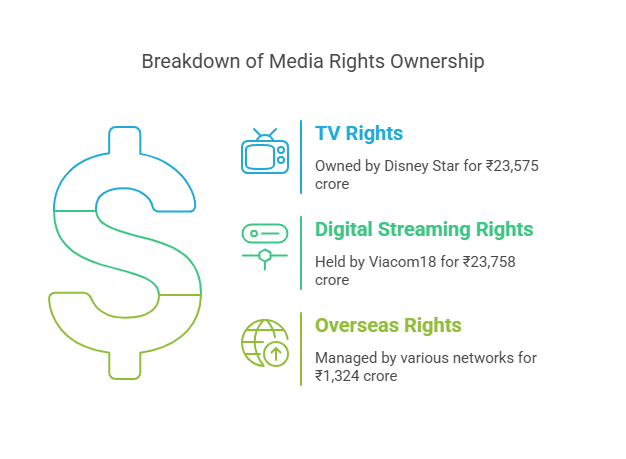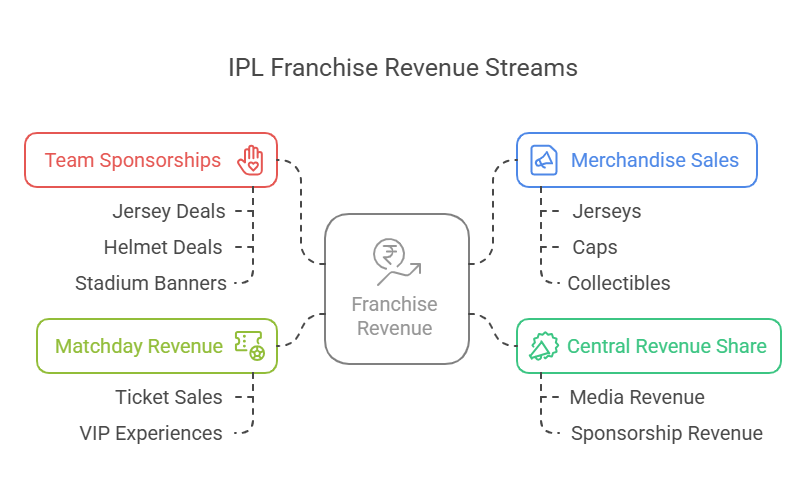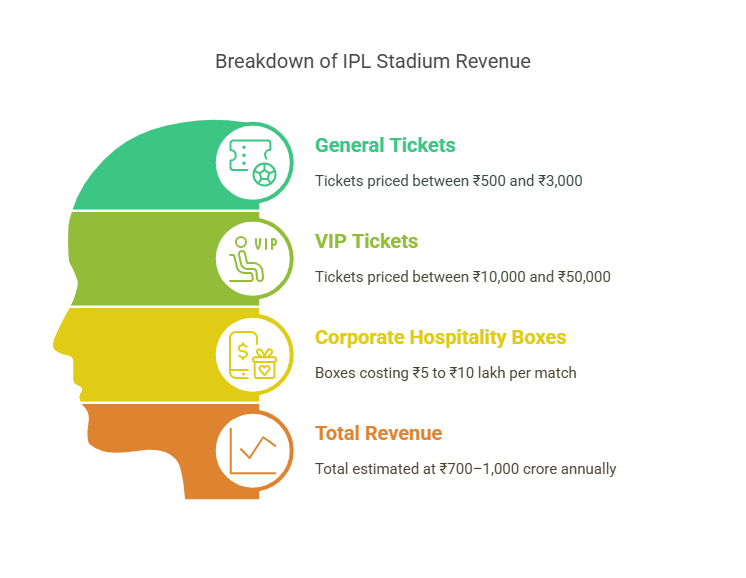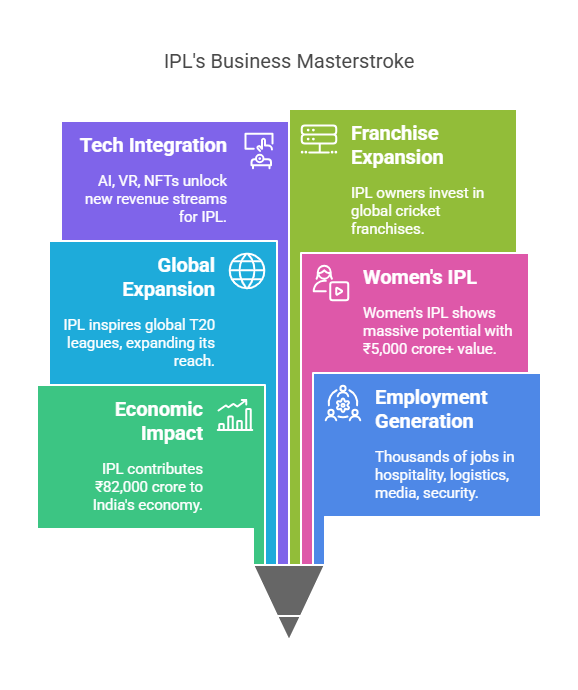Blog
The IPL Business Model: How Cricket Became a Billion-Dollar Industry

The Indian Premier League (IPL) is not just a cricket tournament; it is a global business empire that has revolutionized the way sports are monetized. With a valuation exceeding $12 billion in 2025, IPL has become one of the most lucrative sporting leagues in the world. But how does it generate so much revenue? What makes it different from traditional cricket leagues? Let’s explore the IPL business model in detail.
1. Media Rights: The Biggest Money Maker
The biggest contributor to IPL’s revenue is media rights, which are sold at record-breaking prices. For the 2023–2027 cycle, IPL sold its broadcasting and digital streaming rights for a staggering ₹48,390 crore ($6.2 billion), making it the second most valuable sports league per match globally, after the NFL.
Who Owns the Media Rights?
- TV Rights: Disney Star (₹23,575 crore)
- Digital Streaming Rights: Viacom18 (₹23,758 crore)
- Overseas Rights: Various networks (₹1,324 crore)

Why Are Media Rights So Expensive?
With IPL viewership surpassing 500+ million viewers, it is a goldmine for advertisers. The increasing dominance of digital streaming has led to intense competition between broadcasters, driving up the price of rights. In 2023, JioCinema (Viacom18) streamed IPL for free, attracting record-breaking viewership and challenging the traditional pay-TV model.
💡 Key Insight: The shift to digital streaming is the future of IPL, making it more accessible to a wider audience and increasing monetization opportunities.
2. Sponsorships: A Brand’s Dream Platform
With prime-time TV slots and millions of engaged viewers, IPL is a favorite for brands looking to maximize their reach. The league earns ₹4,500 crore+ in sponsorship revenue annually from multiple partners.
Major Sponsorship Deals in IPL 2025
- Title Sponsor: Tata Group (₹670 crore for 2 years)
- Official Partners: Dream11, Swiggy Instamart, RuPay, CRED
- Umpire & Strategic Timeout Sponsors: Paytm, CEAT

Why Brands Pay Millions?
A 10-second ad slot during IPL matches costs around ₹15–18 lakh. With millions of engaged viewers, brands see IPL as a high-return investment, leading to aggressive bidding wars for sponsorship slots.
💡 Key Insight: IPL isn’t just about cricket—it’s an advertising powerhouse that helps brands boost visibility and engagement.
3. Franchise Revenue: How Team Owners Make Money
Each IPL franchise operates as an independent business entity, generating revenue through various streams:
1. Central Revenue Share
- 50% of IPL’s media and sponsorship revenue is distributed among the 10 franchises.
- In 2023, each franchise earned ₹500+ crore from central revenue alone.
2. Team Sponsorships
- Individual franchises sign deals with brands for jerseys, helmets, and stadium banners.
- Mumbai Indians and Chennai Super Kings have sponsorship deals worth ₹150+ crore per season.
3. Matchday Revenue
- Tickets, hospitality boxes, and VIP experiences contribute significantly.
- A full stadium with 50,000+ spectators generates ₹3–5 crore per match.
4. Merchandise Sales
- Jerseys, caps, and collectibles contribute ₹100–200 crore annually to franchise revenues.
💡 Key Insight: Successful teams like Mumbai Indians and CSK are valued at over $1.3 billion each, rivaling some European football clubs.

4. Ticket Sales & Stadium Revenue
IPL matches are played in some of India’s largest stadiums, with capacities ranging from 30,000 to 70,000+. Ticket pricing varies based on demand:
- General tickets: ₹500–₹3,000
- VIP tickets: ₹10,000–₹50,000
- Corporate hospitality boxes: ₹5–₹10 lakh per match
In a high-profile match, stadium revenue can exceed ₹10 crore per game. With 70+ matches per season, the total ticketing revenue is estimated at ₹700–1,000 crore annually.
💡 Key Insight: Even with digital streaming, live matches remain a major revenue source, proving the enduring appeal of in-person sports experiences.

5. Fantasy Cricket & Betting: The Hidden Revenue Stream
IPL has fueled the rise of fantasy sports platforms, with companies like Dream11, MPL, and My11Circle paying crores in sponsorship deals.
- Dream11 alone recorded ₹3,000+ crore in transactions during IPL 2023.
- Fantasy sports platforms earn through entry fees, memberships, and ads.
Legal Betting & Global Impact
While sports betting is largely restricted in India, offshore betting platforms handle billions in IPL bets, increasing the league’s global viewership and engagement.
💡 Key Insight: The integration of fantasy sports and legal betting could further boost IPL’s financial ecosystem.
6. The Economic Impact of IPL
The IPL is not just a sporting event—it’s an economic powerhouse that contributes significantly to India’s GDP.
Key Economic Contributions
📈 Total Economic Impact: ₹82,000 crore ($10 billion) 👷 Employment Generation: Thousands of jobs in hospitality, logistics, media, and security 🌍 Global Expansion: IPL has inspired T20 leagues in South Africa, UAE, and the USA
💡 Key Insight: The IPL’s model is now being replicated globally, proving its effectiveness as a business template for sports leagues.
7. Future of IPL: What’s Next?
🚀 Women’s IPL Expansion: The Women’s Premier League (WPL) debuted in 2023 and is already valued at ₹5,000 crore+, showing massive potential. 📲 Tech Integration: AI-powered engagement, VR experiences, and NFT collectibles could unlock new revenue streams. 🌍 Global Franchise Expansion: IPL owners now invest in SA20, Major League Cricket (USA), and ILT20 (UAE).
💡 Key Insight: The IPL is not slowing down—it’s expanding globally, integrating technology, and redefining sports business models.

Final Over: IPL as the Ultimate Business Masterstroke
The IPL business model is a perfect blend of media rights, sponsorships, team revenues, ticket sales, fantasy sports, and global expansion. What started in 2008 with $723 million in revenue is now a $12 billion+ industry and is expected to hit $20 billion soon.
📢 Do you think IPL will become the world’s biggest sports league in the next decade? Let’s discuss in the comments!
